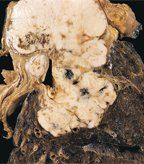ASCO: Pemetrexed Maintenance Therapy Better Than Placebo for Advanced NSCLC
Final results of the PARAMOUNT study in non-squamous non–small-cell lung cancer confirmed improved survival with continuation pemetrexed maintenance therapy.
The final survival results from the PARAMOUNT study in nonsquamous non–small-cell lung cancer confirmed that continuation maintenance therapy with pemetrexed (Alimta) improves survival compared with placebo. The investigators say these results warrant a change in the treatment paradigm for patients in this setting.

This large-cell carcinoma at autopsy shows a large multilobulated tumor adjacent to the hilum. A metastatically involved lymph node is present next to the bronchus.
“This is the first study to show that continuation maintenance had a clear impact on the natural course of the disease in advanced NSCLC, including an improvement in progression-free survival and overall survival,” said lead investigator Luis Paz-Ares, MD, of Seville University Hospital in Spain.
The PARAMOUNT phase III trial looked at whether continuation maintenance therapy with pemetrexed is useful following induction chemotherapy with a pemetrexed and cisplatin regimen. The progression-free survival results were presented at last year’s annual meeting of the American Society of Clinical Oncology, and data on the primary endpoint was also published this year in the Lancet Oncology; the final survival results confirmed the success of this regimen.
The study randomized 539 patients to either a pemetrexed arm (359 patients) or a placebo arm (180 patients). All patients underwent induction therapy with four cycles of pemetrexed and cisplatin, and then the pemetrexed arm received pemetrexed continuation maintenance therapy until disease progression while the placebo arm received best supportive care. The two groups were evenly matched with regard to rates of response to induction therapy (44% complete or partial response in the pemetrexed arm vs. 42% placebo arm).
The overall survival from the point of randomization was 13.9 months, compared with 11 months in the placebo group. Pemetrexed yielded a statistically significant 22% reduction in the overall risk of death, for a hazard ratio of 0.78 (95% CI, 0.64–.096). The investigators also measured overall survival from the beginning of induction therapy, and found the same result.
“The goals of maintenance therapy, as are the goals of all treatment in patients with advanced NSCLC, and perhaps all advanced cancers, is to prolong survival, and to improve or maintain quality of life,” said Gregory Kalemkerian, of the University of Michigan; he was not involved with the study. Kalemkerian said that this study clearly shows pemetrexed prolongs survival, but data on quality of life suggests it may only be similar to placebo.
Over a median follow-up of 12.5 months, 37% of pemetrexed patients completed more than 6 cycles of the drug, compared to 18% of placebo patients. The pemetrexed group averaged 7.9 cycles in total, compared with 5 cycles.
At 12 months, 58% of pemetrexed patients survived, compared with 45% of placebo patients; at 24 months, these rates dropped to 32% and 21%. Subgroup analyses showed trends or significant overall survival improvements for all subgroups measured, including by disease stage, ECOG score, age, and other factors.
There were more serious adverse events with the study drug compared to placebo, with 4.7% of pemetrexed patients experiencing grade 3 or 4 fatigue and 6.4% suffering grade 3 or 4 anemia. For placebo, the rates were 1.1% and 0.6%, respectively. Serious neutropenia occurred in 5.8% of pemetrexed patients and in no placebo patients. Dr. Kalemkerian said that pemetrexed is generally a very well-tolerated drug in this patient population.
“The most important strength of this trial was the selection of a tolerable maintenance drug; the use of a drug that actually can be maintained,” Dr. Kalemkerian said.